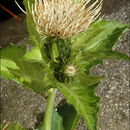en
names in breadcrumbs


Cirsium oleraceum, the cabbage thistle[3] or Siberian thistle, is a species of thistle in the genus Cirsium within the family Asteraceae, native to central and eastern Europe and Asia, where it grows in wet lowland soils.[4]
Cirsium oleraceum is a herbaceous perennial plant growing to 1.5 m tall, the stems unbranched or with only a very few branches. The leaves are broad and ovoid, with a weakly spiny margin, being pinnatipartite. The flowers are produced in dense flower heads which are 2.5–4 cm diameter, pale yellow, but sometimes tinged pink.[5]
Its specific epithet oleraceum means "vegetable/herbal" in Latin and is a form of holeraceus (oleraceus).[6][7]
For cooking: In salads the young stems and leaves are edible, and cultivated for food in Japan and India.

Cirsium oleraceum, the cabbage thistle or Siberian thistle, is a species of thistle in the genus Cirsium within the family Asteraceae, native to central and eastern Europe and Asia, where it grows in wet lowland soils.
Cirsium oleraceum is a herbaceous perennial plant growing to 1.5 m tall, the stems unbranched or with only a very few branches. The leaves are broad and ovoid, with a weakly spiny margin, being pinnatipartite. The flowers are produced in dense flower heads which are 2.5–4 cm diameter, pale yellow, but sometimes tinged pink.
Its specific epithet oleraceum means "vegetable/herbal" in Latin and is a form of holeraceus (oleraceus).